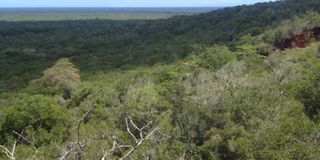Arabuko Sokoke Forest is a paradise for bird watchers

Arabuko Sokoke forest as it is seen from the Sokoke view point, six Kilometres deep into the forest. he forest, which is 41,600 hectares, cuts across Malindi, Ganze and Magarini sub-counties. PHOTOS | KAZUNGU SAMUEL | NATION MEDIA GROUP
What you need to know:
- The forest, which is 41,600 hectares, cuts across Malindi, Ganze and Magarini sub-counties.
- The forest was gazetted in 1943 after it was declared a crown land by the colonists in 1932. Twenty per cent of bird life in Kenya is found in Arabuko Forest.
At least 30kms from Malindi town is Arabuko Sokoke Forest.
It is the second most important sanctuary for birds in Africa after the Congo Forest, according to Gede Forest station manager Blessing Maghanga.
At the gate are signposts of various government agencies in the forest, which is under the Kenya Forest Service (KWS) and managed by Gede station.
The forest, which is 41,600 hectares, cuts across Malindi, Ganze and Magarini sub-counties.
Mr Maghanga said the forest is an ideal place for family visits, picnics and adventures.
“In the morning, visitors can view birds as the sun rays penetrate into the forest,” he said.
“Visitors are allowed to venture deep into the forest to the legendary Sokoke view point where one is able to see the spectacular three forest zones clearly marked,” said Mr Maghanga.
The forest was gazetted in 1943 after it was declared a crown land by the colonists in 1932. Twenty per cent of bird life in Kenya is found in Arabuko Forest.
KWS warden in charge of Arabuko Sokoke Forest Dennis Ombuna said it hosts an elephants population of between 150-200.
“It is sometimes difficult to get the exact number of the elephants because the forest is very thick to penetrate. We always depend on dung count and the footprints in our report,” he said.
The forest is also home to buffaloes and some endangered animals including Ader’Duiker, Golden-rumped Sengi (Elephant Shrew), Clarkes Weaver, Sokoke Scops Owl, Spotted Ground Thrush, Amani Sunbird and Sokoke pipit.
Research scientists at the Kenya Forestry Research Institute Nereoh Leley and Riziki Mwadalu said the forest has three zones, which can be seen clearly at Sokoke view point.
“We have the mixed forest zone, which has different tree species, the Brachystegia spiciformis (Zebrawood) zones, adjacent to the mixed zones and the Cynometra Webberi (species of legumes) zone,” they said.




